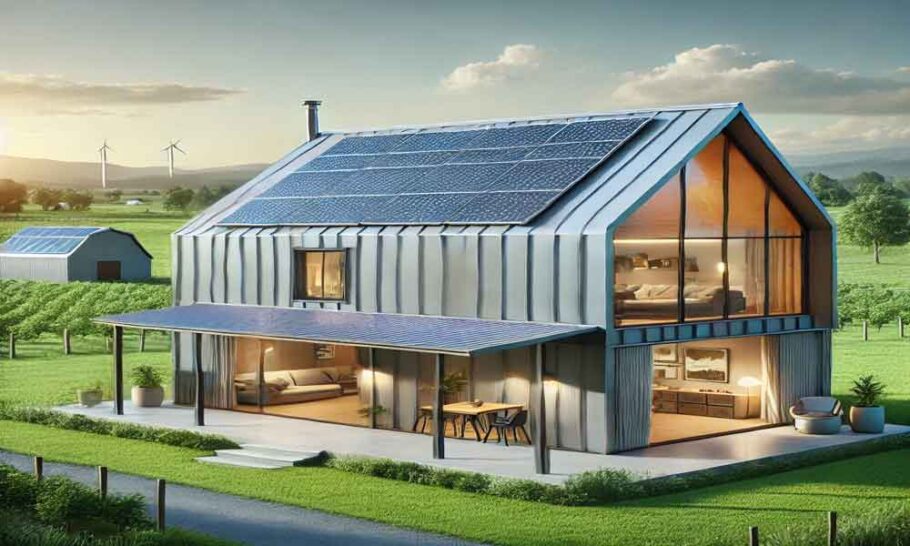As more people embrace sustainable living, the idea of building off-grid barndominiums is becoming increasingly popular. A barndominium’s simple design, affordability, and adaptability make it an excellent choice for those seeking self-sufficiency. However, off-grid living requires careful planning and engineering to ensure a functional and comfortable home. From power generation to waste management, this guide will explore key engineering considerations for designing a barndominium that operates independently of traditional utilities.
1. Power Generation: Renewable Energy Solutions
One of the biggest challenges of off-grid living is generating a reliable power supply. Designing a barndominium with energy independence in mind means incorporating renewable energy systems that suit your location and needs.
Solar Power
- Why Solar? Solar panels are one of the most popular options for off-grid homes because they are efficient, scalable, and environmentally friendly.
- Installation Considerations:
- Design your barndominium roof with optimal solar panel placement in mind, ensuring it is angled correctly and unobstructed by shade.
- Include space for a battery bank to store energy for nighttime or cloudy days. Lithium-ion batteries are a common choice due to their longevity and efficiency.
- System Size: Calculate the energy demands of your household, including lighting, appliances, and heating/cooling systems, to determine the size of the solar array and battery storage needed.
Wind Power
- Why Wind? Wind turbines are a great supplement to solar power, particularly in areas with consistent wind patterns.
- Installation Considerations:
- Ensure your property has adequate wind speed, typically above 10-15 mph, for efficient energy production.
- Place turbines at least 30 feet higher than any nearby structures or trees to maximize exposure to wind.
Backup Generators
While renewable energy systems can handle most of your power needs, a backup generator fueled by propane or diesel can provide extra security during extreme weather or periods of low renewable energy production.
2. Water Supply: Accessing and Storing Water
An off-grid barndominium must have a reliable water source and efficient systems for collection, storage, and purification.
Wells
- Why Choose a Well? A private well provides a consistent, long-term water supply.
- Engineering Considerations:
- Test the property for groundwater availability and quality.
- Install a solar-powered or wind-powered pump for sustainable water extraction.
- Consider adding a storage tank to ensure an uninterrupted supply during pump maintenance.
Rainwater Harvesting
- Why Rainwater? Rainwater harvesting is an eco-friendly way to supplement your water needs, particularly in areas with frequent rainfall.
- Installation Considerations:
- Design your barndominium roof with gutters and downspouts that direct water into a collection system.
- Use filtration and treatment systems to ensure the water is safe for drinking, cooking, and bathing.
- Incorporate a cistern or tank to store collected rainwater.
Water Conservation
To minimize water usage:
- Install low-flow fixtures for sinks, showers, and toilets.
- Use greywater recycling systems to reuse water from sinks and showers for irrigation or toilet flushing.
3. Waste Management: Sustainable Solutions
Proper waste management is crucial for maintaining hygiene and environmental sustainability in an off-grid home.
Septic Systems
- Why Septic? Septic systems are a reliable solution for managing wastewater in rural areas.
- Engineering Considerations:
- Design a system sized appropriately for your household’s needs.
- Regularly maintain the tank and drainage field to avoid issues.
Composting Toilets
- Why Composting? Composting toilets are an eco-friendly alternative to traditional septic systems, especially in areas where installing a septic system is impractical.
- Key Features:
- Require little to no water.
- Convert waste into compost material over time.
Solid Waste Management
- Plan for composting organic waste from food and landscaping.
- Incorporate a recycling station into your barndominium design to minimize landfill waste.
4. Heating and Cooling: Energy-Efficient Solutions
Maintaining a comfortable indoor temperature is essential, especially in areas with extreme weather. Off-grid barndominiums can use innovative heating and cooling systems to stay energy-efficient.
Passive Design Features
- Why Passive Design? Passive strategies reduce energy consumption by using natural elements.
- Design Tips:
- Orient the barndominium to maximize solar gain in winter and minimize heat in summer.
- Use energy-efficient windows and insulation to reduce heat transfer.
- Include overhangs, awnings, or vegetation for shading.
Wood-Burning Stoves
For heating, wood-burning stoves are a practical choice in off-grid homes, especially if you have access to a sustainable wood source.
Geothermal Heating and Cooling
Geothermal systems use the earth’s stable underground temperature to regulate indoor temperatures. While the upfront cost is high, they are extremely efficient and require minimal energy to operate.
5. Lighting and Appliances: Maximizing Energy Efficiency
To reduce energy demand:
- Install LED lighting, which uses significantly less energy than traditional bulbs.
- Choose Energy Star-rated appliances designed for minimal energy consumption.
- Incorporate natural lighting through large windows, skylights, or solar tubes to reduce daytime electricity usage.
6. Building Materials and Insulation
The materials you use can impact your barndominium’s efficiency and comfort.
- Use steel framing, which is durable and sustainable.
- Choose insulation with a high R-value, such as spray foam or rigid foam, to improve temperature control and reduce heating/cooling costs.
- Opt for materials like reclaimed wood or bamboo to align with sustainable living practices.
Conclusion
Designing an off-grid barndominium requires careful planning and engineering to ensure your home is self-sufficient, functional, and sustainable. By incorporating renewable energy systems, efficient water solutions, and sustainable waste management strategies, you can enjoy a comfortable lifestyle while reducing your environmental footprint. With the right design choices, your off-grid barndominium can serve as a model for independent, eco-friendly living.

